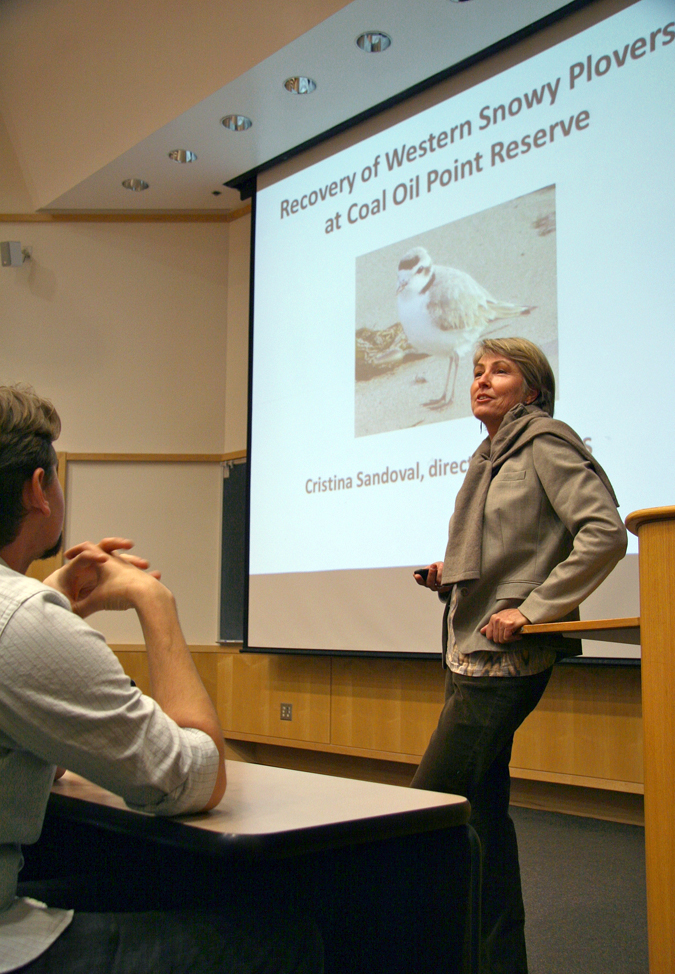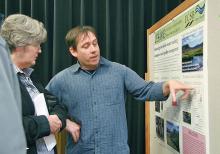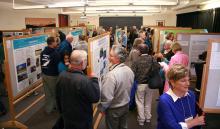


Shorelines, woodlands, streams, and deserts were the stars of the moment, as UC Santa Barbara's natural reserves were highlighted at the inaugural Natural Reserve System Day. The full day of presentations and poster sessions was sponsored by the UCSB Natural Reserve System. Held at the Bren School of Environmental Science & Management, the event featured speakers intimate with the thousands of acres that serve as outdoor classrooms and laboratories.
"We're here to serve California. The main goals are to enhance teaching, research and public service of our natural lands, to support the economy and the ecosystem of the State of California by doing this work at these sites," said Patricia Holden, director of the UCSB Natural Reserve System (NRS) and a Bren School professor.
The UC Natural Reserve System is a network of 38 wildland sites that span over 750,000 acres across the state, from forests to deserts, mountains to coastlines. It is the world's largest university-operated system of natural reserves, administered by nine of the 10 UC campuses.
UC Santa Barbara administers seven reserves –– the most of any of the UC campuses –– ranging from the nearby Coal Oil Point on the coast just off campus to the Sierra Nevada Aquatic Research Laboratory (SNARL) in eastern California.
"It's like a library of California's native habitats and ecosystems," said Sue Swarbrick, associate director of the UC NRS. Prior to the NRS founding in 1965, long-term research in California's ecologically diverse array of habitats was often limited or halted by development, or uses of the land that would interfere with researchers' work. The objective of the reserve system, she said, is to set aside natural areas where uninterrupted research can be performed. The reserves are a tremendous resource, which the system is hoping to promote to current and future researchers.
"We really wanted to have this event to raise awareness of the NRS to the University community and anyone who would be interested," Swarbrick said. "We really hope to attract more graduate students."
The day was filled with fascinating presentations by faculty and researchers, to rooms packed with people from UCSB and the Santa Barbara region, including representatives from the Santa Barbara Museum of Natural History and the local chapter of the Audubon Society.
Each reserve has its unique qualities. For instance, Coal Oil Point, one of UCSB's original reserves, is the nearest and most easily accessible of the reserves, but its location adjacent to highly populated areas presents a challenge to Cris Sandoval, director of the Coal Oil Point reserve. For the past 15 years, Sandoval has been working to boost the population of the endangered snowy plover, a tiny shorebird that shares its nesting sites of the same sand that hosts countless visitors and their dogs.
"This was an opportunity to create a lot of conservation awareness in our local community," said Sandoval. Several research projects, classes, tours, and funding have come from research at Coal Oil Point, she said. Through trial and error, Sandoval, who described herself initially as an insect biologist "who didn't know how to talk to people, or to handle them," discovered the kind of approach that could be used to effectively create a safe haven for the birds despite the intense use of the beaches near which they lay their eggs.
"I did nothing to the plovers," she said at the end of her presentation. "What I did was I managed people."
In other reserves, such as the Sedgwick Reserve in the Santa Ynez Valley, and the Kenneth S. Norris Rancho Marino Reserve farther up the California coast, it's not animals that are being edged out, but native grasses, which are being overtaken by invasive European species. Restoration is a major part of managing the reserves in the NRS system.
"How can a manager tip the balance toward these more desirable native species?" asked Carla D'Antonio, professor in the UCSB Department of Ecology, Evolution and Marine Biology. The answer might lie in the very activity that brought the invasive nonnatives in the first place: livestock grazing.
Though historically associated with the shift from native grasses to the preponderance of nonnative species in previously grazed lands, livestock grazing is now also one of the few tools available to those who want to manage and restore native grassland on a large scale, said D'Antonio. Her lab is interested in just how widespread the seemingly beneficial effects of grazing might be, as well as how ecological and topographical factors may play a role in the outcomes of grazing.
But the reserves aren't just about hard sciences. For Lynn Gamble, UCSB professor of archaeology, the Santa Cruz Island Reserve, known for its unique evolution and diverse marine ecosystem, is perfect for studying the Chumash, the Native American hunter-gatherers who lived in the region for millennia and thrived prior to contact with European settlers.
"This is a site where I've always dreamed of working," she said of the island's west end, a location that now holds more documented house depressions –– 51 –– than any other archaeological site in the Santa Barbara Channel area. While there may have been sites as large or larger on the mainland, it's the island's remoteness that has helped to keep this particular site, named El Monton, safe from the destruction wrought by modern human activity.
"We can really reconstruct what life was like going back through time, and we don't have to be hampered with development," she said.
Meanwhile, Hank Pitcher, artist and alumnus from the UCSB College of Creative Studies, has used the reserves as inspiration, capturing Coal Oil Point and Sedgwick
reserves on canvas through several decades, often in anticipation of development that would change the landscape.
"I tend to paint the same view over and over again, so when somebody asks me how long does it take to make a painting, I can say it took my whole life," he quipped.
Elizabeth Hiroyasu is a grad student who was lured to the life of an environmental scientist by the reserves. Now studying at the Bren School, her earliest years were formed by many field trips to SNARL. Her love for the playground of her childhood translated into a deeper understanding and support for the reserve, and all the UC natural reserves in general.
"I think they're hugely important to the UC system –– not just for research, but also for their K-12 education," she said, commenting on the NRS effort to bring nature education to schoolchildren.
"It's amazing."
Learn more about the University of California Natural Reserve System at nrs.ucop.edu.
Related Links



